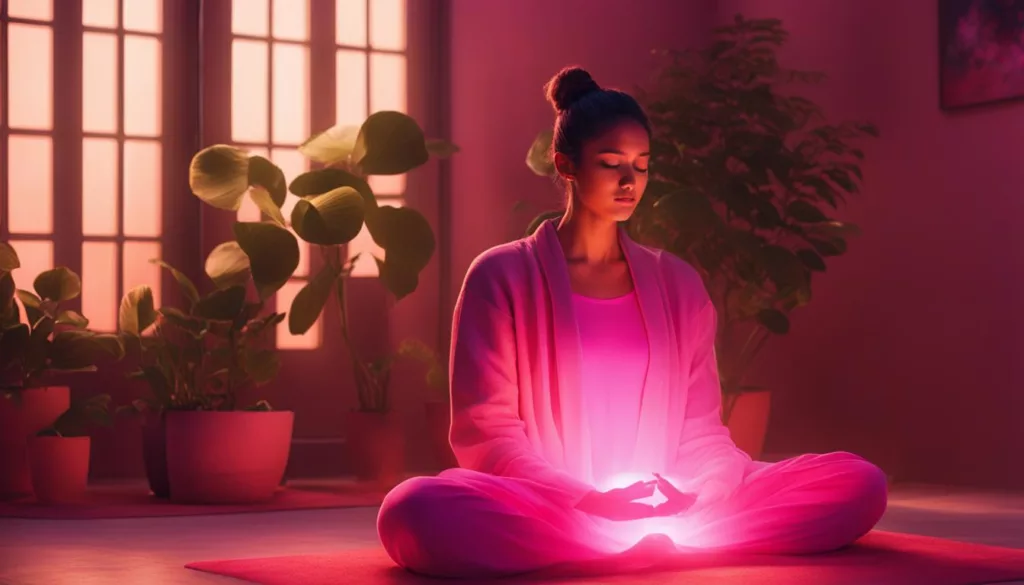9 Best Strategies for Anxiety Relief Through Mindful Meditation
Anxiety is a common and overwhelming experience for many of us. It can affect every aspect of our lives, from work to personal relationships. While seeking professional help is important, there are also several self-help strategies, like meditation, that can significantly reduce anxiety levels. In this article, we will explore nine powerful meditation techniques that can help you manage anxiety and find a sense of calm and balance in your life. These techniques, rooted in mindfulness, have been proven effective in relieving anxiety and promoting overall well-being. Whether you are new to meditation or an experienced practitioner, these strategies can be easily incorporated into your daily routine to help alleviate anxiety and cultivate a peaceful state of mind.
Key Takeaways
- Mindful meditation is a powerful tool for managing anxiety and promoting well-being.
- There are nine effective strategies for anxiety relief through mindful meditation.
- These strategies can be easily incorporated into your daily routine.
- Meditation techniques such as mindfulness, deep breathing, guided visualization, body scan, loving-kindness, progressive muscle relaxation, mantra meditation, and Yoga Nidra can help reduce anxiety and promote relaxation.
- Consistency and patience are key for harnessing the transformative power of mindfulness.
Mindfulness Meditation: A Powerful Technique for Anxiety Relief
When it comes to managing anxiety, one technique that has gained significant attention is mindfulness meditation. By incorporating mindfulness practices into your daily routine, you can effectively reduce anxiety levels and promote a sense of calm and balance in your life. Mindfulness meditation involves focusing your attention on the present moment, paying close attention to your thoughts, feelings, and bodily sensations without judgment.
Through regular practice, you can become more aware of your anxiety triggers and develop tools to manage them effectively. Mindfulness meditation can be practiced anywhere, anytime, making it a convenient and accessible technique for managing anxiety. Numerous studies have shown that mindfulness meditation significantly reduces anxiety levels and improves overall well-being.

During mindfulness meditation, you learn to accept your thoughts and feelings without trying to change them. This non-judgmental attitude helps reduce the power anxiety has over you and allows you to cultivate a greater sense of peace and tranquility. By incorporating mindfulness meditation into your anxiety relief techniques, you can develop a more positive relationship with your thoughts and emotions, leading to reduced anxiety and improved mental well-being. Mindfulness meditation is a valuable tool for managing anxiety and promoting a sense of calmness and serenity in your life.
The Benefits of Mindfulness Meditation for Managing Anxiety
- Reduces anxiety levels
- Promotes a sense of calm and balance
- Increases self-awareness of anxiety triggers
- Improves overall well-being
Practicing mindfulness meditation allows us to become more grounded in the present moment, reducing anxiety and promoting a sense of peace and tranquility in our lives.
By incorporating mindfulness meditation into your daily routine, you can manage anxiety and cultivate a greater sense of well-being. The benefits of mindfulness meditation extend beyond anxiety relief, with numerous studies showing its positive impact on mental health and overall quality of life. Take the time to incorporate mindfulness practices into your life and experience the transformative power of mindfulness meditation.
Section 3: Deep Breathing Exercises for Anxiety Relief
In addition to mindfulness meditation, another effective technique for reducing anxiety and promoting relaxation is deep breathing exercises. These exercises, such as diaphragmatic or abdominal breathing, can be easily incorporated into your daily routine and provide immediate relief from anxiety symptoms.

Deep breathing exercises work by activating the body’s relaxation response. By taking slow, deep breaths, you stimulate the parasympathetic nervous system, which helps counteract the stress response and promotes a sense of calmness and tranquility. The rhythmic breathing pattern also helps shift your focus from anxious thoughts to the present moment, allowing you to let go of tension and anxiety.
To practice deep breathing, find a comfortable position and place one hand on your abdomen. Inhale deeply through your nose, allowing your belly to rise as you fill your lungs with air. Exhale slowly through your mouth, feeling your belly fall. Repeat this pattern for several breaths, focusing on the sensation of your breath and the rise and fall of your abdomen. You can practice deep breathing exercises anytime you feel anxious or stressed, helping you find relief in moments of overwhelm.
Mindful Meditation: Guided Visualization for Anxiety Relief
Anxiety can be a challenging and overwhelming experience, affecting every aspect of our lives. While seeking professional help is crucial, there are self-help strategies we can incorporate into our daily routine to manage anxiety. Guided visualization is a powerful meditation technique that uses mental imagery to create a sense of calm and relaxation. By vividly imagining a peaceful and serene place, we can escape anxiety’s grip and cultivate a state of tranquility.
Incorporating guided visualization into our mindfulness practice offers several benefits for anxiety relief. This technique engages our imagination, allowing us to tap into the power of mental imagery. It helps us redirect our thoughts away from anxious thoughts and creates a safe mental sanctuary where we can find solace.
During guided visualization, we are guided through a journey to our chosen peaceful place. We might envision a tranquil beach, a serene forest, or any location that brings us a sense of calmness. By engaging all of our senses in this visualization, we can immerse ourselves fully in the experience, bringing a profound sense of relaxation and relief from anxiety.

Example of a Guided Visualization Script:
Imagine yourself walking along a beautiful, white sandy beach. Feel the warmth of the sun on your skin and hear the gentle sound of the waves crashing against the shore. Take a deep breath and let the soothing ocean breeze fill your lungs.
As you continue walking, notice the vibrant colors of the seashells scattered along the sand. Bend down, pick one up, and feel its smooth texture in your hands. Let its beauty remind you of the beauty within yourself.
Find a comfortable spot to sit and close your eyes. Take another deep breath in, and as you exhale, let go of any tension or worry. Now, visualize a radiant golden light surrounding your body, filling you with warmth and peace.
As you bask in this golden light, feel all the anxiety and stress melting away. Your body feels lighter, your mind at ease. Know that you are safe and protected in this moment of serenity.
Stay in this peaceful place for as long as you need, allowing the healing energy of guided visualization to wash over you. When you are ready, slowly open your eyes and return to the present, carrying the sense of calmness and relief with you.
Guided visualization can be a valuable tool for anxiety relief, providing a refuge from the chaos of our thoughts and emotions. By incorporating this technique into our mindfulness practice, we can find inner peace and cultivate a greater sense of well-being.
Section 5: Body Scan Meditation
Body scan meditation is a powerful practice that can help alleviate anxiety and promote mindfulness. This technique involves systematically bringing awareness to each part of your body, from your toes to the top of your head. By directing your attention to different areas of your body, you can cultivate a deep sense of relaxation and release tension that may be contributing to your anxiety.
During body scan meditation, you can lie down in a comfortable position or sit in a chair with your feet flat on the ground. Close your eyes and take a few deep breaths to center yourself. As you begin the practice, bring your focus to your toes. Notice any sensations, tension, or discomfort in that area. Take a moment to acknowledge it without judgment, allowing any tension to melt away as you exhale.
Continue this process of awareness and relaxation as you gradually move up through each part of your body. Pay attention to your feet, ankles, calves, knees, thighs, hips, and so on. Take your time with each area, noticing any sensations, emotions, or thoughts that arise. If you encounter tension or discomfort, breathe into that area and consciously release it on the exhale.
Body scan meditation can help you develop a deeper connection with your body and enhance your awareness of bodily sensations. By regularly practicing body scan meditation, you can reduce anxiety, increase mindfulness, and promote a sense of calmness and well-being.

Benefits of Body Scan Meditation
- Promotes relaxation and stress reduction
- Increases body awareness and mindfulness
- Relieves physical tension and discomfort
- Enhances self-care and self-compassion
- Fosters a sense of calmness and balance
Body scan meditation is a valuable tool for managing anxiety and promoting overall well-being. Incorporate this practice into your daily routine to cultivate a deeper connection with your body, reduce stress, and find inner peace. Remember, consistency is key, so commit to regular practice and embrace the transformative power of body scan meditation.
Anxiety Relief Through Loving-Kindness Meditation
Anxiety can often leave us feeling isolated and trapped in our own negative thoughts. One powerful technique that can help us break free from this cycle is loving-kindness meditation. This form of meditation focuses on cultivating feelings of compassion, both for ourselves and for others. By practicing loving-kindness meditation, we can develop self-compassion and cultivate kindness towards ourselves and those around us.
Research has shown that practicing loving-kindness meditation can have a profound impact on reducing anxiety levels. By directing well-wishes towards ourselves and others, we can shift our focus away from our anxieties and foster a sense of connection and empathy. This practice helps us replace negative self-talk with self-compassion, which is essential for managing anxiety effectively.
A key aspect of loving-kindness meditation is the use of positive phrases or intentions, often referred to as “metta” in Pali, the language of early Buddhist texts. These phrases are repeated silently or aloud during meditation, and they can vary depending on the individual’s preferences. Some commonly used phrases include “May I be happy and at peace,” “May I be free from suffering,” “May I live with ease,” and “May all beings be safe and protected.” By repeating these phrases, we send positive energy and well-wishes to ourselves and others, creating a ripple effect of kindness and compassion.
“Loving-kindness meditation allows us to open our hearts and cultivate a sense of connection and empathy towards ourselves and others.”
During loving-kindness meditation, it’s normal for distracting thoughts or negative emotions to arise. When this happens, we gently acknowledge them without judgment and return our focus to the practice. Over time, we develop the ability to approach our anxieties with kindness and understanding, rather than being consumed by them.
Summary
Loving-kindness meditation is a powerful anxiety relief technique that allows us to cultivate compassion and kindness towards ourselves and others. By practicing this form of meditation, we can develop self-compassion, reduce anxiety levels, and foster a sense of connection and empathy. Through the repetition of positive phrases or intentions, we send well-wishes to ourselves and all beings, creating a ripple effect of kindness and compassion. Embracing loving-kindness meditation can empower us to break free from negative self-talk, manage anxiety effectively, and live with a greater sense of peace and well-being.

Muscle Relaxation Techniques for Anxiety Relief
When it comes to managing anxiety, relaxation techniques can play a crucial role in promoting a sense of calmness and reducing stress levels. One such technique is progressive muscle relaxation, a powerful method that focuses on releasing tension from the body and promoting muscle relaxation. By systematically tensing and relaxing different muscle groups, progressive muscle relaxation can effectively reduce anxiety and promote a sense of physical and mental well-being.
During a progressive muscle relaxation session, you can start by finding a quiet and comfortable space. Close your eyes and take a few deep breaths to center yourself. Begin by tensing and then relaxing your toes, moving upwards through each muscle group in your body. As you tense each muscle group, hold the tension for a few seconds, and then release it, focusing on the sensation of relaxation.
As you progress through your body, from your feet to your legs, abdomen, arms, and ultimately to your face and head, be mindful of any areas of tension or discomfort. By bringing awareness to these areas and consciously relaxing them, you can release built-up tension and promote relaxation throughout your body. Progressive muscle relaxation can be practiced daily or whenever you feel overwhelmed by anxiety, offering a simple yet effective way to manage your symptoms and find relief.
The Benefits of Progressive Muscle Relaxation
Progressive muscle relaxation offers several benefits for individuals struggling with anxiety:
- Stress Reduction: By systematically releasing tension from the body, progressive muscle relaxation can help reduce stress levels and promote a deep sense of relaxation.
- Muscle Tension Release: Many people carry tension in their muscles, especially during periods of anxiety. Progressive muscle relaxation allows you to pinpoint areas of tension and consciously release them, promoting physical and mental relaxation.
- Anxiety Relief: The practice of progressive muscle relaxation can significantly reduce anxiety symptoms by promoting a sense of calmness and relaxation throughout the body.
By incorporating progressive muscle relaxation into your self-care routine, you can effectively manage anxiety and cultivate a greater sense of well-being. Remember to practice consistently and be patient with yourself as you learn to release tension and find relaxation. With time and dedication, progressive muscle relaxation can become a valuable tool in your anxiety relief toolkit.

Mindful Meditation: Cultivating Inner Peace with Mantra Meditation
When it comes to anxiety relief techniques, mantra meditation stands out as a powerful practice that focuses the mind and promotes inner peace. By engaging in repetitive chanting, we can calm our racing thoughts and find serenity amidst the chaos. Mantra meditation has been practiced for centuries and continues to be a go-to method for individuals seeking relief from anxiety.
In mantra meditation, we choose a word, phrase, or sound (mantra) and repeat it silently or aloud. The rhythmic repetition of the mantra allows us to shift our attention away from anxious thoughts and redirect it towards a place of tranquility. By focusing on the mantra, we create a positive and harmonious vibration within ourselves, fostering a sense of inner peace and stillness.
One of the beauties of mantra meditation is its simplicity and versatility. It can be practiced anywhere, anytime, making it an accessible tool for managing anxiety in our daily lives. Whether we are sitting in a quiet room or navigating a stressful situation, we can rely on mantra meditation to ground ourselves and find a place of calm amidst the storm.
Beyond Anxiety Relief: The Transformative Power of Mantra Meditation
While mantra meditation is an effective anxiety relief technique, its benefits extend beyond the realm of stress reduction. This practice has the potential to unlock our inner potential and connect us to a deeper sense of self. Through the repetition of the mantra, we can cultivate focus, clarity, and heightened awareness.
Mantra meditation can also serve as a gateway to spiritual growth and self-discovery. As we dive deeper into the practice, we may start to experience a profound sense of connection to something greater than ourselves. The repetitive chanting can open the door to transcendent experiences, allowing us to tap into our innate wisdom and connect with the divine.
“By focusing on the mantra, we create a positive and harmonious vibration within ourselves, fostering a sense of inner peace and stillness.”
If you’re new to mantra meditation, it’s important to choose a mantra that resonates with you. You can select a word or phrase that holds personal significance or explore traditional mantras from various spiritual traditions. Experiment with different mantras and see which one evokes a sense of calm and focus within you.
Remember, mantra meditation is a journey. It may take time to find the perfect mantra and establish a regular practice. Be patient with yourself and approach the process with an open mind and heart. With dedication and consistency, mantra meditation can become a cherished tool for navigating the challenges of life and cultivating inner peace.

Section 9: Yoga Nidra – Deep Relaxation for Anxiety Relief
Yoga Nidra, also known as yogic sleep, is a powerful relaxation technique that can provide profound relief from anxiety. This practice involves guided meditation and conscious relaxation of the body and mind, inducing a state of deep relaxation and restoration. Yoga Nidra can be particularly beneficial for individuals who struggle with insomnia or find it challenging to unwind and quiet the mind.
During a Yoga Nidra session, you are led through a series of visualizations, breathing exercises, and body awareness techniques. By following the instructions, you gradually enter a state of tranquility and calmness. This practice promotes the release of physical and mental tension, allowing you to experience deep relaxation and rejuvenation.
Research has shown that Yoga Nidra can reduce anxiety levels, improve sleep quality, and enhance overall well-being. It can help you connect with your inner self, release stress, and cultivate a sense of inner peace. By integrating Yoga Nidra into your bedtime routine or practicing it during times of heightened anxiety, you can effectively manage stress, find relief from anxiety, and promote deep relaxation for a better quality of life.
| Benefits of Yoga Nidra | How It Helps |
|---|---|
| Reduces anxiety and stress | By inducing a state of deep relaxation and releasing tension |
| Improves sleep quality | By calming the mind and promoting restful sleep |
| Enhances overall well-being | By fostering a sense of inner peace and connection |
Whether you choose to practice Yoga Nidra on your own or with a guided meditation recording, this technique can provide a powerful tool for anxiety relief and deep relaxation. Take some time each day to explore the benefits of Yoga Nidra and experience the transformative effects it can have on your well-being.

Conclusion
Mindfulness meditation is a powerful and effective tool for managing anxiety and promoting a sense of calmness and well-being. By incorporating these anxiety management techniques into your daily routine, you can reduce stress and find relief from anxiety. Whether you choose to practice mindfulness meditation, deep breathing exercises, guided visualization, body scan meditation, loving-kindness meditation, progressive muscle relaxation, mantra meditation, or Yoga Nidra, each technique offers unique benefits for anxiety relief.
These mindfulness practices for calmness can be easily integrated into your life, allowing you to cultivate a peaceful and balanced state of mind. Remember, managing anxiety is a lifelong practice, and with consistency and patience, you can harness the transformative power of meditation to live a more meaningful and fulfilling life.
Incorporate these techniques in your daily routine, and you will discover the positive impact they can have on your overall well-being. So, take a moment each day to prioritize your mental health and invest in your own self-care. Start your journey towards anxiety relief and stress reduction with the power of mindfulness meditation. You deserve the calmness and tranquility that comes with it.
FAQ
What is mindfulness meditation?
Mindfulness meditation is a practice that involves focusing your attention on the present moment, paying close attention to your thoughts, feelings, and bodily sensations without judgment. It is a powerful technique for managing anxiety and promoting overall well-being.
How does deep breathing help with anxiety?
Deep breathing exercises, such as diaphragmatic or abdominal breathing, activate your body’s relaxation response, reducing anxiety and stress levels. By taking slow, deep breaths, you can calm your nervous system and promote relaxation.
What is guided visualization?
Guided visualization is a meditation technique that involves imagining a peaceful and serene place. By vividly visualizing this place, you can create a mental sanctuary to escape to when anxiety strikes. Guided visualization can calm your mind and promote relaxation.
How does body scan meditation help with anxiety?
Body scan meditation involves systematically bringing awareness to each part of your body, releasing tension and stress. It helps you reconnect with your body, relieve physical symptoms of anxiety, and cultivate a sense of calmness and relaxation.
What is loving-kindness meditation?
Loving-kindness meditation, also known as Metta meditation, focuses on cultivating feelings of compassion and love, first for yourself and then for others. By directing well-wishes towards yourself and others, you can counteract negative self-talk and promote emotional well-being.
How does progressive muscle relaxation help with anxiety?
Progressive muscle relaxation involves tensing and then relaxing different muscle groups, releasing physical tension. This technique is particularly helpful for individuals who experience muscle tightness during anxious moments, promoting a sense of physical and mental well-being.
What is mantra meditation?
Mantra meditation involves repeating a word, phrase, or sound (mantra) silently or aloud. The repetitive nature of this practice helps redirect your thoughts away from anxiety-inducing topics, promoting inner peace, focus, and tranquility.
What is Yoga Nidra?
Yoga Nidra, also known as yogic sleep, is a guided meditation practice that induces deep relaxation. It can be particularly beneficial for those who struggle with insomnia due to anxiety. Through conscious relaxation of the body and mind, Yoga Nidra promotes restful sleep and reduces anxiety levels.
How can mindful meditation help with anxiety?
Mindful meditation, along with the other techniques discussed in this article, can significantly reduce anxiety levels and promote a sense of calmness and well-being. By incorporating these strategies into your daily routine, you can cultivate a peaceful state of mind and live a more fulfilling life.






